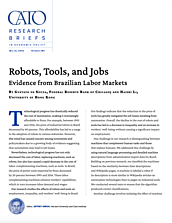Technological progress has drastically reduced the cost of automation, making it increasingly affordable to firms. For example, between 1995 and 2016, the price of industrial robots in Brazil decreased by 40 percent. This affordability has led to a surge in the adoption of robots in various industries. However, this trend has caused concern among economists and policymakers due to a growing body of evidence suggesting that automation may lead to job losses.
Nevertheless, technological progress has not only decreased the cost of labor-replacing machines, such as robots, but also has caused a rapid decrease in the cost of labor-complementing machines, such as tools. In Brazil, the price of power tools imported by firms decreased by 20 percent between 1995 and 2016. These labor-complementing machines enhance workers’ capabilities, which in turn increases labor demand and wages.
Our research studies the effects of robots and tools on employment, inequality, and workers’ well-being in Brazil. Our findings indicate that the reduction in the price of tools has greatly mitigated the job losses resulting from automation. Overall, the decline in the cost of robots and tools has led to a decrease in inequality and an increase in workers’ well-being without causing a significant impact on employment.
One challenge in our research is distinguishing between machines that complement human tasks and those that replace humans. We addressed this challenge by using natural language processing and detailed machine descriptions from administrative import data for Brazil. Building on previous research, we classified the machines based on the similarity between their descriptions and Wikipedia pages. A machine is labeled a robot if its description is more similar to Wikipedia articles on automation technologies than to pages on industrial tools. We conducted several tests to ensure that the algorithm produced correct classifications.
Another challenge involves isolating the effect of machine adoption on labor market outcomes from other factors. Conditions in local economies affect the importation of machines. For instance, if increased consumer demand led firms to increase their demand for robots, we would not be able to distinguish the extent to which the labor market outcomes changed due to higher consumer demand versus increased robot adoption.
We addressed this challenge by studying changes in tariffs for imported machines. Tariffs affect the final price of imported machines and thereby influence firms’ incentives to adopt them, but they are unrelated to labor market changes. There are several pieces of evidence supporting this claim. First, tariffs do not correlate with past labor market trends. Second, tariff changes are not correlated with campaign contributions. Third, tariffs do not correlate with other relevant policies of the period, such as subsidized loans or federal procurement.
Our research finds that tools increase the employment and wages of lesser-skilled workers who operate machinery. A 1 percent increase in tool imports would increase the employment of lesser-skilled workers by 0.26 percent and increase their wages by 0.06 percent without any effect on higher-skilled workers. The effect of tools is concentrated among workers directly involved in operating machinery.
On the other hand, the adoption of robots causes large disruptions in the labor market. A 1 percent increase in robot adoption decreases employment by 0.35 percent. Similar to tools, the effect of robots is concentrated among lesser-skilled workers in operational occupations. These findings suggest that if tool and robot adoption increase by the same proportion, the net effect on employment would be close to zero.
Our analysis suggests that the declining prices of robots and tools over the past 20 years have improved workers’ well-being and reduced inequality without significant consequences for employment. Employment has remained stable because the lower costs of tools have offset the increased adoption of robots. These cost reductions have enabled firms to lower the prices of final goods, boosting production and benefiting workers’ well-being.
Note
This research brief is based on Gustavo de Souza and Haishi Li, “Robots, Tools, and Jobs: Evidence from Brazilian Labor Markets,” Federal Reserve Bank of Chicago Working Paper no. 2023–42, January 2024.

This work is licensed under a Creative Commons Attribution-NonCommercial-ShareAlike 4.0 International License.
